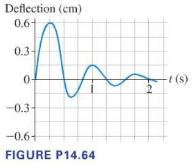A jellyfish can propel Deflection ((mathrm{cm})) itself with jets of water pushed out of its bell, a
Question:
A jellyfish can propel Deflection \((\mathrm{cm})\) itself with jets of water pushed out of its bell, a flexible structure on top of its body. The elastic bell and the water it contains function as a mass-spring system, greatly increasing efficiency. Normally, the jellyfish emits one jet right after the other, but we can get some insight into the jet system by looking at a single jet thrust. Figure P14.64 shows a graph of the motion of one point in the wall of the bell for such a single jet; this is the pattern of a damped oscillation. The spring constant for the bell can be estimated to be \(1.2 \mathrm{~N} / \mathrm{m}\).
a. What is the period for the oscillation?
b. Estimate the effective mass participating in the oscillation. This is the mass of the bell itself plus the mass of the water.
c. Consider the peaks of positive displacement in the graph. By what factor does the amplitude decrease over one period? Given this, what is the time constant for the damping?
Step by Step Answer:

College Physics A Strategic Approach
ISBN: 9780321907240
3rd Edition
Authors: Randall D. Knight, Brian Jones, Stuart Field




